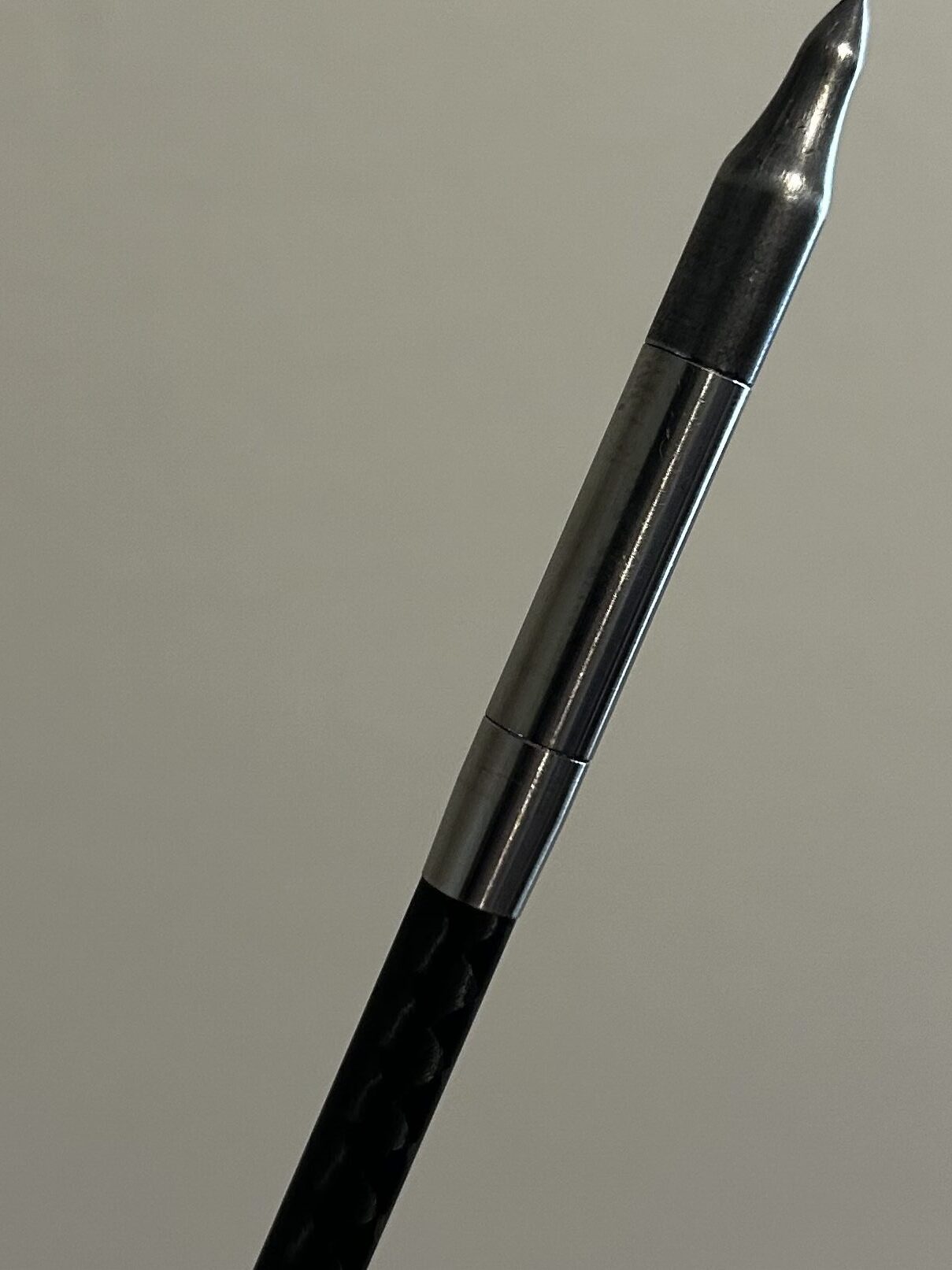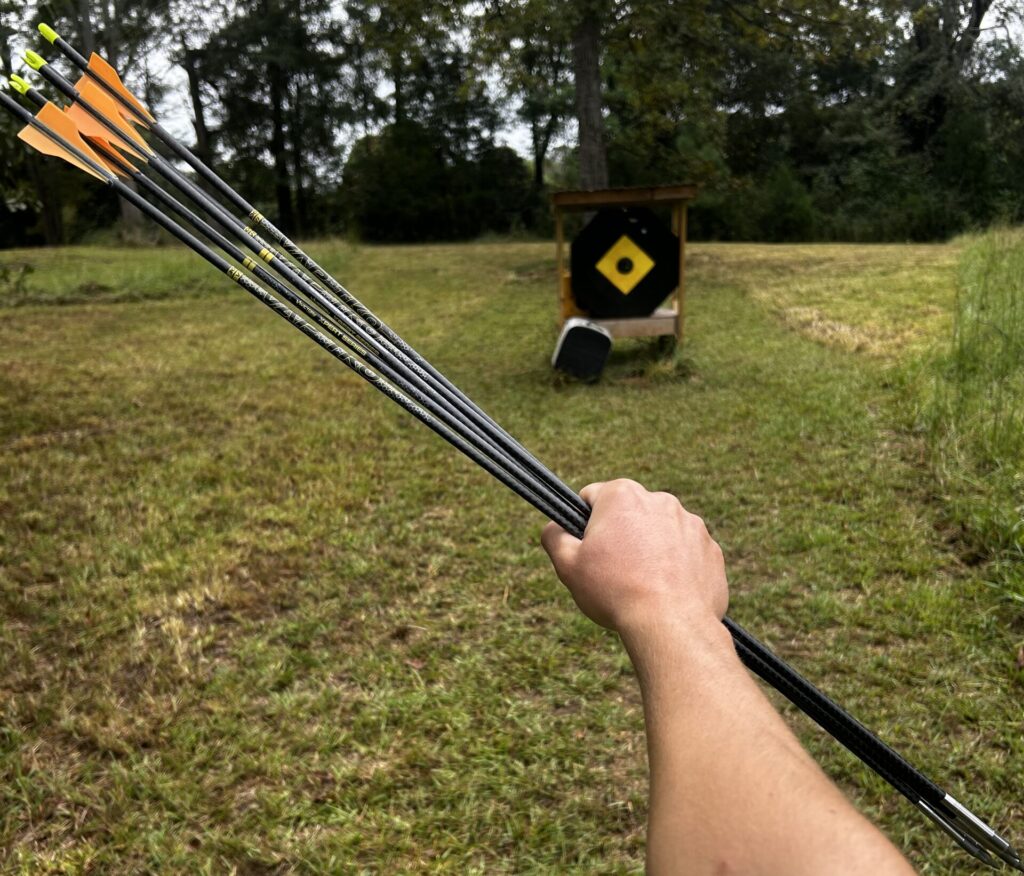The Best Science-Based Arrow Build for Hunting-2025
Building arrows is a practice that brings out the nerd in every bowhunter. It is a continual quest year after year to create the most efficient arrow possible. Every year we as hunters adjust and make small changes attempting to squeak every drop of optimization we can out of our setups. Arrow building is the pinnacle of what it means to be a dedicated archer. In every aspect of archery we will not stop testing, evaluating, and reassessing our methods as we chase perfection. For the 2025 archery season I believe my arrow build is as good or better than anything it can be put up against. This article will guide you through the components and methods I use to create the ideal hunting arrow.
Arrow Build Components at a Glance
- Victory VAP TKO V1 Elite 300 spine
- DCA Mini Sabre vanes fletched at a 2degree left helical
- Podium Archer .166 Titanium 2-Piece 60 gr Half Out
- Podium Archer Hardened Steel Field Point
- Fletched using an OMP Phoenix Fletching Jig
- Bob Smith Industries Maxi-cure Cyanoacrylate glue
- Primer Pen
- Hot Melt Glue for the Half Out Install
Why I Chose the Components I Did
In this article you will hear me reference a study done recently which aimed to determine what the best vane and arrow combo is. This study was sponsored by Easton with the help James Yates(@yates_in_the_backcountry) and Precision Cut Archery. I won’t go into the specifics of the study on this post, but they did a fantastic job of collecting some real, hard data on what makes an efficient and accurate arrow. A link to the study can be found here:https://www.precisioncutarchery.com/research/arrow-study-2025. Most of the build decisions I made were directly influenced by this study.
Arrow Choice
Going into the new season I decided I would switch to 4mm arrows. I like the lower wind resistance and look of the small 4mms. In the past, the downside of 4mm arrows was the lack of componentry choices. However, this issue is basically non-existent with the creation of Podium Archer’s .166 titanium half-outs(more on these later). Additionally, the Arrow Ballistics Study found that 4mms exhibit a 10% higher aerodynamic efficiency than 5mms. Though 4mms are typically heavier than 5mms, this is a sacrifice I am willing to make, as I know the added gpi(grains per inch) will not push me too high. Having ran RIP TKOs in the past, I knew I wouldn’t be disappointed with the VAP TKOs.
Vane Choice and Configuration
Of all the vanes in the Arrow Ballistics Study, the DCA Super Sabres stood out among the rest. Not only did they display a fantastic balance of drag vs arrow stabilization, they were also some of the quietest vanes tested. Now, I have elected to use the Mini Sabres for this arrow build, a scaled down version of the Super Sabres. Unfortunately the Minis were not tested in the study. However, trusted archers contend that the Minis have been shown to stabilize broadheads just as well as their full size counterparts. The Minis are also not as tall, therefore leading to greater sight housing clearance for long range shooting.

Something the study also showed is that 2degrees of helical and 3 vanes are optimal for aerodynamic efficiency. Higher helical and more vanes both increase drag exponentially with no meaningful stability gains. I’ll also be running left helical as my bow clocks to the left. Josh Jones (Podium Archer), who got to talk to some of the researchers in the study, mentioned that they found left helical to be more accurate. However, it is unclear if this is true only for bows that naturally spin/clock arrows to the left, or if the left helical is more accurate no matter the clocking. Either way, I know my bow clocks to the left, so that’s what I’ll be going with.
Outserts
Having ran Victory’s standard aluminum 50gr outserts for the past year, I knew I would be making a change going into this season. I can’t tell you how many of those weak aluminum tubes I’ve bent. Any slight bump off of a tree or the ground bends them out of square. Additionally, the sharp edges and ridges they possess make them harder to pull from targets. For me there were only two options to consider for inserts/outserts: easton deep six inserts or Podium Archer two piece titanium half outs.
The deep six system is essentially a scaled down hit insert that utilizes smaller threads. Therefore, broadheads and field points utilizing the deep six system can be screwed down inside of the arrow. This provides a mounting system that ensures points will be aligned perfectly straight with the arrow. Also, impact collars can be added to the system to reduce the chances of splintering at the end of the arrow. This is a fantastic system for archers that don’t like outserts. However, you can only use field points and broadheads that utilize deep six thread patterns, potentially limiting your broadhead choices.
Podium Archer’s titanium 2-Piece half outs are the ideal choice for those who want to continue using points with standard thread pitches. From the titanium construction to the extremely high tolerances, these half outs are fantastic. Plus, they accept Gold Tip Fact weights if you want to add weight for a higher foc. However, the 60grains that they start at is right where I want to be. They also provide different collar sizes to really get a snug, sleek fit on your arrow of choice. Moreover, these half outs suit my fancy perfectly for thus arrow build.

Field Points
My field point selection is pretty straight forward. I, of course, want a component that is durable and won’t bend easily. So, the hardened steel option was a no-brainer. Plus, they are the exact same diameter as the Podium half outs making for a gorgeous fitment. These field points also have an O-ring above the threads which really keeps them from vibrating loose.
The OMP Phoenix Fletching Jig
I had the privilege of using the OMP Phoenix Fletching Jig to put the vanes on these arrows. Coming from a bitzenburger jig, I can’t say enough good things about this jig. It made the entire fletching process a breeze and it provides all of the adjustments I need in a fletching jig. I’ll post a full in-depth review of this jig at a later date.

The Results of this Arrow Build
This arrow build turned out great. I was able to get them all within .7gns of 446.5gns. With an FOC of 13.7%, they fly great. The new arrows are heavier, so I did have to step up to a more stretched sight tape. This unfortunately means I did lose some yardage. I can go to approx. 110yds before i run into vane clearance issues. After broadhead tuning, I am hitting the same spot with field points and fixed blade broadheads at up to 90 yds. These arrows stabilize broadheads very well for me. They’re super accurate, and they’re noticeably quieter than my previous arrows. Overall, I’m very happy with the performance of the arrows.


